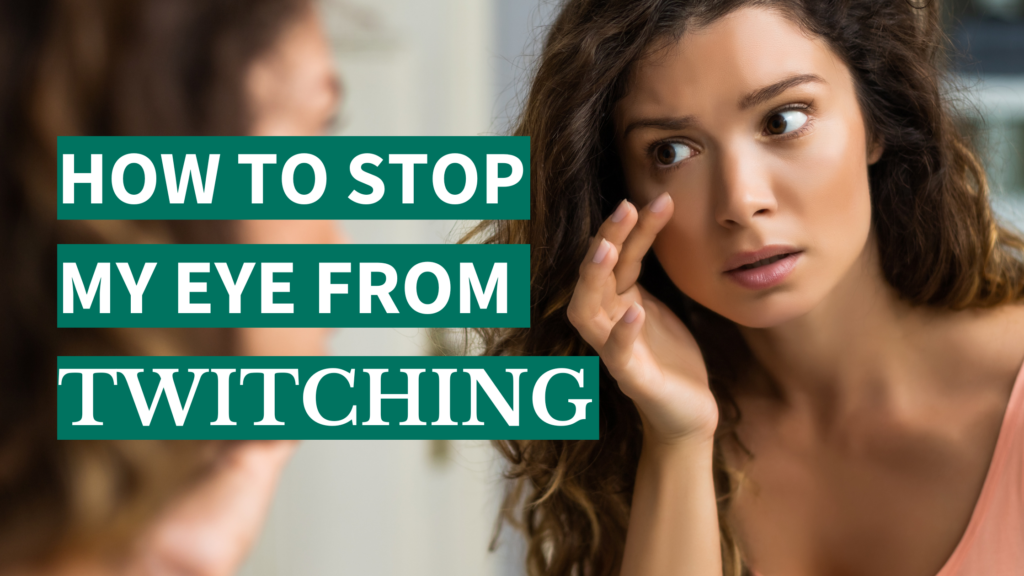
Eyelid twitching can be so irritating! It can feel impossible to ignore. Dr. Leanne Stunkel, MD, a renowned neuro-ophthalmologist who offers expert care for complex neurological disorders as they affect the visual system discuss a common problem that many of us face: how to stop our eyes from twitching.
What is eyelid twitching?
At times, the small muscle that surrounds and closes the eye can develop involuntary (uncontrollable) twitches.
Patients may have short bursts of twitching lasting seconds at a time, and the twitching episodes can come and go for days to weeks.
Medical terms for eyelid twitching are eyelid myokymia or blepharomyokymia.
What causes eyelid twitching?
Eyelid twitching is extremely common!
It is usually triggered by stress, too much caffeine, not enough sleep, or a combination of all of those. Certain medications, such as pyridostigmine, can also trigger eyelid twitching as a side effect.
What can I do about it?
If you are having eyelid twitching, the first step is to try to get more sleep, decrease the amount of caffeine you are using, and make sure to hydrate!
Below are some more detailed tips:
- Hydration: Drink at least 64 oz of water daily (approx. 8 glasses daily).
- Cut down on caffeine: Too much caffeine can trigger eyelid twitching. Too much caffeine can also lead to poor sleep, which can also contribute to eyelid twitching.
- Improve Sleep:
- Sleep at least 7 hours per night
- Go to bed at the same time every night and get up at the same time each morning.
- Avoid screens (including phones, computers, tablets, and TV) for at least an hour before bed.
- Avoid caffeine in the late afternoon or evening.
- Minimize alcohol, especially in the evening.
- Sleep in a cool, dark room.
- If you snore, have restless sleep, wake up gasping for air, or are very sleepy during the day, consider getting tested for obstructive sleep apnea, a treatable condition that can cause poor sleep and chronic headaches.
Click here to learn more about how to improve your sleep.
When should I be concerned?
Eyelid twitching is almost always benign, or harmless. As long as the eyelid twitch is only in one eye and is isolated—meaning there are no other symptoms or problems—it is not likely to indicate anything harmful.
Patients sometimes feel concerned if an eyelid twitch keeps happening for days or even weeks, but this is actually very common!
After working on the triggers (sleep deprivation, caffeine, stress, etc.) the twitch should get better slowly over time.
What if the eyelid twitch does not go away?
If an eyelid twitch continues for more than 6 months, we do an MRI/ MRA (magnetic resonance imaging and angiography) to make sure there is nothing else going on. However, in most cases this is normal. Even if an eyelid twitch keeps going on for over a year, it is likely harmless.
If an eyelid twitch does not go away, treatment with botulinum toxin injections can be used to stop the twitching.
When is an eyelid twitch not just an eyelid twitch?
If an eyelid twitch is affecting both eyes or is not isolated—meaning that there are additional symptoms or issues—then something else may be going on.
These conditions may be confused for eyelid twitching:
- Hemifacial spasm: In this condition, patients have strong muscle contractions of an entire side of the face. The contractions are often strong enough to close the eye. The cheek moves as well, and the upper lip is pulled up. Patients need an MRI to look for underlying issues. Botulinum toxin injections are a treatment.
- Blepharospasm: In this condition, patients have uncontrollable eyelid closure, usually affecting both eyes. It can be triggered by eye surface problems, wind, sunlight, and stress. Sometimes touching the eyelid, coughing, talking, eating, or chewing gum may help patients keep the eyelids open. Botulinum toxin injections are also a treatment for blepharospasm. Treating any dry eye or corneal disease is also important.
- Eye blinking tic: Tics are suppressible but involuntary. This means that people can delay the movements but cannot stop doing them. They feel a strong urge to perform the movement when trying to avoid it. Eye blinking can be a tic. Tics usually start in childhood.
When should I talk to my doctor?
Talk to your doctor about eyelid twitching if:
- It keeps happening for more than 6 months.
- The eyelid or both eyelids are closing or nearly closing during the episodes.
- There is twitching of other parts of the face.
- You have any changes in awareness or lose consciousness during episodes of twitching.
Additional Resources:
American Academy of Ophthalmology Website: “What Is an Eyelid Spasm or Twitching Eyelid?” https://www.aao.org/eye-health/diseases/eyelid-spasm-twitch
Mayo Clinic Website: “Eye twitching.” https://www.mayoclinic.org/symptoms/eye-twitching/basics/definition/sym-20050838
References:
Bacci ED, Coyne KS, Poon JL, Harris L, Boscoe AN. Understanding side effects of therapy for myasthenia gravis and their impact on daily life. BMC Neurol. 2019; 19: 335. PMID: 31864345.
Banik R, Miller NR. Chronic myokymia limited to the eyelid is a benign condition. J Neuroophthalmol. 2004;24(4):290-2. PMID: 15662242.
Jafer Chardoub AA, Patel BC. Eyelid Myokymia. [Updated 2023 Aug 8]. In: StatPearls [Internet]. Treasure Island (FL): StatPearls Publishing; 2024. Accessed 2 March 2024. Available from: https://www.ncbi.nlm.nih.gov/books/NBK560595/.
Miller NR. Eyelid myokymia. Surv Ophthalmol. 2011;56(3):277-8. PMID: 21501741.
